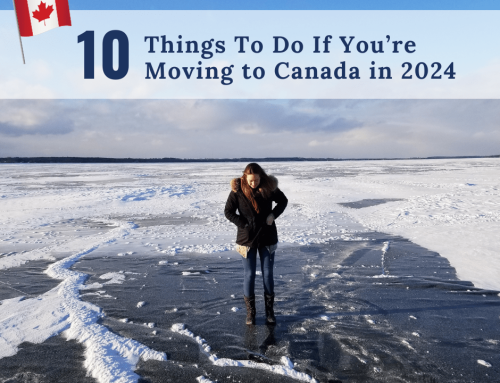International Experience Canada: IEC Work Permit Guide
So you’ve decided you want to work & travel in Canada with an IEC International Experience Canada work permit – You’ve made the best decision!
My IEC visa was granted in January 2017 and it was the most amazing feeling of relief and excitement. It can get pretty overwhelming and there were plenty of times during the process when I wished that I had somebody to talk to about it. So here I am for you!
*DISCLAIMER: This guide will explain my experience with each stage of the IEC application process back in 2017. Requirements may well have changed since then so I strongly recommend you check the IRCC website for up-to-date information! I figure this guide may still be useful to know what to expect and I can share some of my best tips to make it as easy as possible. Give me a shout with any problems, worries, or questions – I would really love to help in any way I can.
1. Are you eligible?
On the Government of Canada website (click here), you can find out if you are eligible to apply for the IEC International Experience Canada visa. I would say this is definitely the most important first step to find out exactly where you stand, as your eligibility depends on your country of citizenship’s agreement with Canada.
If, like me, your country/ territory of citizenship is the United Kingdom, this means that what you need falls under the ‘Working Holiday’ IEC category:
“The Working Holiday category is designed for British citizens who intend to travel in Canada and who wish to find temporary paid employment to help pay for their trip (up to 24 months).”
To be eligible for this, you must:
- Be a British citizen from the UK, Channel Islands of Jersey and Guernsey.
- Have a valid UK passport for the duration of your stay in Canada.
- Be between 18 – 30 years of age.
- Possess a minimum of $2,500 CAD
(I made sure to have this amount, however, this was never once checked throughout my application, or even when activating my visa at the Canadian border…) - Have health insurance for the duration of your stay.
(Again, I made sure to have this but it was not checked at all either – I probably wouldn’t risk it though!)
2. Enter yourself into the ‘pool’ of candidates
Once you complete the eligibility section of the website and you know your citizenship’s relevant category, the website should give you details on the pool’s availability.
The ‘pool’ is a list of all applicants who are currently requesting to apply for that particular work permit visa category. Once the pool opens, candidates can create a profile, submit it into the pool and then wait to essentially be ‘picked out of a hat’ for the chance to apply officially.
The Government of Canada is notoriously secretive with their pool opening dates and even big travel companies like STA and BUNAC do not know in advance when this will happen.
*TIP* During this uncertain time, I signed up for the BUNAC newsletter (click here) and I would definitely recommend doing this. I regularly received updates on the IEC International Experience Canada visa pool and was eventually notified by the newsletter when it opened – Or you can just regularly check the Government of Canada website yourself!
3. Wait for your ‘invitation to apply’
Once the pool is declared open and you have submitted your profile – all you can do is wait!
I was surprised at how little information I was able to give to support my profile – They really just ask the basics. There wasn’t really the chance to make myself stand out from others which was frustrating but I can only guess this is done to make it as fair as possible for everyone.
It can get nerve-wracking when time passes and you are still not chosen out of the visa pool. I was checking the website daily to track the number of invitations already given out and how many were left! All I can say is have faith that your time will eventually come.
*TIP* Request your supporting documents whilst you are in the IEC pool waiting for your invitation to apply! Once you accept the invite there are only 20 days to complete your visa application.
4. Complete your application
After you receive your email invitation to apply, you can do a happy dance and burst into tears of relief – Then the hard work begins!
There are a lot of documents that the application requires but they are all relatively easy to acquire so don’t panic. If you are still waiting for certain documents when you reach the deadline, you can submit proof that you have requested it and are still waiting so please don’t worry too much!
Bear in mind all applications are different but I personally needed to gather the following for mine:
- UK Police Certificate
- Australian Police Certificate (because I had recently lived there for a period of more than 6 months)
- CV/ Resume
- Passport – This had to be scanned in its entirety (along with every single one of my stamped pages!) *This has to be 1 SINGLE JPEG FILE ONLY. I just googled ‘combine JPEGs’ and was able to use a free online tool to make multiple photos into 1 long one.
- Digital Photo – Exact photo dimensions required are given. I downloaded a free app on my phone that could crop to specific measurements. This saved me having to pay a photography store to take it!
- Family Information Form (contact details, dates of birth, etc). This is provided to you to complete.
(I did not need to obtain a medical exam because I was not planning on working in any of the relevant job fields and hadn’t travelled to any countries that require one.)
*TIP* I struggled with my files being too large for upload. I googled ‘compress JPEG’ or ‘compress PDF’ and used free online tools to make my files smaller.
After I finally paid my fees and submitted my application, I received an email about a week later requiring a further document: My Australian driving record!
This proves that there really isn’t a definitive list of documents that you may need – I wasn’t expecting to have to obtain this at all (and still not sure why I had to?!) but it was relatively easy to get after a couple of phone calls down-under.
I received my IEC International Experience Canada work permit visa approval approximately a week later! Hallelujah!
5. Prepare for your arrival
It sounds obvious, but when you arrive in Canada, you want to have everything organized to present to the Border Officers. Even though you may have received your IEC International Experience Canada work permit visa approval email, you still need to activate the visa at the Canadian border.
I printed out copies of all my supporting documents that I had submitted in my application and filed them in a folder/binder. I also ensured I had proof of funds, insurance, and anything else that the email instructed.
They asked me a few questions with regards to my application but it was pretty straightforward – and I got a fancy-looking work permit document complete with a gold emblem to show for all my efforts!
*Don’t call the Border Officers ‘Security Guards’ like my fiance did. They don’t like that…
Don’t forget to join the Newcomer Collective so you don’t miss out on any of our inspiring interviews and valuable ‘life in Canada’ lessons.
And, if you found this post helpful, pass it on to your fellow newcomers!









